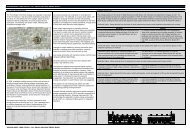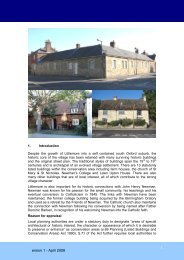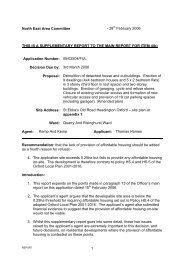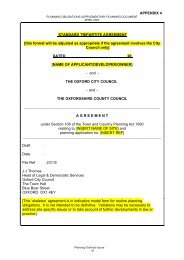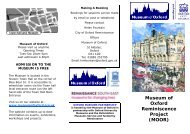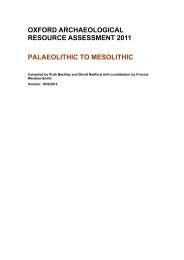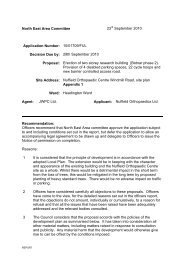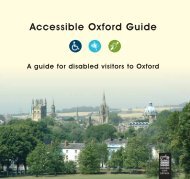Post-medieval Oxford - Oxford City Council
Post-medieval Oxford - Oxford City Council
Post-medieval Oxford - Oxford City Council
Create successful ePaper yourself
Turn your PDF publications into a flip-book with our unique Google optimized e-Paper software.
originated in the 12 th century and were making paper by the 18 th century (Rocque’s<br />
map of Berkshire 1761). The buildings were demolished in 1960 and ashlar stone<br />
walls of the main mill channel are all that remains. The nearby mill house, ‘Paisley<br />
House’, built to obstruct the opening of the Great Western Railway, was notable for<br />
being largely constructed of cardboard. The mill site was subject to limited test pitting<br />
in 2006, producing a fragment of 18 th or 19 th lead window frame and 18 th -19 th pottery<br />
(<strong>Oxford</strong> Archaeology 2006).<br />
Quarrying<br />
Headington parish was an important source of local stone from at least the 14 th<br />
century (Arkell 1947). Medieval and post-<strong>medieval</strong> quarrying followed a typical<br />
method of extraction from a shallow pit, which was abandoned as the difficulties of<br />
deep extraction outweighed the benefits; the pit was then abandoned in favour of<br />
another site. This method of extraction resulted in the highly fragmented landscape<br />
still visible today. The main area of quarrying is in the east of the parish, north of the<br />
old London Road. From the 16 th century, the quarry area was recognised as a hamlet<br />
of Headington (Mason 1989: 363). Quarrying was at its most productive in the post<strong>medieval</strong><br />
period partly due to the major rebuilding programmes underway in the<br />
colleges and several acts were passed to facilitate transport of the stone including<br />
turn-piking the London Road and attempts to increase navigation on the rivers and<br />
later the canals. Documentary evidence from college archives concerning quarries in<br />
Headington during the 17 th century indicate that at least nine quarries were held by<br />
the colleges while others were held by the quarrymen themselves (Cole 1960: 64).<br />
Wolvercote has also seen frequent periods of quarrying since the <strong>medieval</strong> period<br />
and evidence of 16 th and 17 th century gravel quarrying has been recorded on<br />
Wolvercote Common (Lambrick and McDonald 1985).<br />
Extensive urban quarrying for gravel.<br />
Urban and suburban quarry sites have also been recorded around the town. For<br />
example, at Queen Elizabeth House, St Giles (UAD 562), to the rear of St John’s<br />
College North Quad (Lawrence 2003: 8), Parks Road (UAD 361), 3 Beaumont<br />
Buildings (UAD 574) and George Street (UAD 381). Gravel digging at the Castle,<br />
testified by the recent excavations, is depicted on Rooker’s painting of the Castle in<br />
1779.<br />
Inns and taverns<br />
Many of <strong>Oxford</strong>’s historic inns continued in use from the late <strong>medieval</strong> period, and<br />
can be traced from their property records and the <strong>City</strong>’s licensing of inn signs (Salter<br />
1926). Notable examples are the George in George Street; the Star, Crown,<br />
Roebuck, and Cross in Cornmarket, the Mitre, Bear, Ram, Angel and King’s Head in<br />
High Street; and the New Inn, Red Lion and Fleur de Lys, Blue Boar, and Dolphin in<br />
St Aldate’s. Notable investigations of inn buildings have included the Clarendon Hotel<br />
(Star and King’s Head), (Pantin 1958), and the Golden Cross (Pantin and Rouse<br />
1955). Archaeological investigation has also encountered limited evidence relating to<br />
the operation of post-<strong>medieval</strong> inns, though post-<strong>medieval</strong> pottery finds from<br />
unpublished salvage sites (e.g. Sturdy at Russell Acotts) include high status inn<br />
material. An assemblage of 17 th century tankard and clay pipes from St Thomas’s<br />
Street suggested the presence of an inn that was gone by the 18 th century (Norton et<br />
al. 2006). Pottery from 65 St Giles indicated that the building had been a public<br />
house from the 16 th century, a century earlier than previously thought (Norton and<br />
Cockin 2008).<br />
OXFORD ARCHAEOLOGICAL RESOURCE ASSESSMENT- POST MEDIEVAL<br />
34



